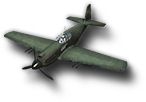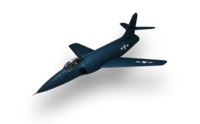XF-90
XF-90
| 6100000 Price |
| 700 Survivability |
| 10376 kgWeight |
| 1231.9 Damage |
| 2572.8 Airspeed |
| 1150 km/hTop Speed at Sea Level |
| 1150 km/hTop Speed at Best Altitude |
| 3000 mOptimum Altitude |
| 1200 km/hMaximum Dive Speed |
| 178.2 m/sRate of Climb |
| 300 km/hStall Speed |
| 851 km/hOptimum Airspeed |
| 79.2 Controllability |
| 17.3 sAverage Time to Turn 360 deg |
| 90 °/sRate of Roll |
| 829.9 Maneuverability |

Tech Tree
 X
X| Specifications: | |
| Engine Power, hp | |
| Type | |
| Weight, kg | |
 X
X X
X| Specifications: | |
| Engine Power, hp | |
| Type | |
| Weight, kg | |
 X
X X
X| Specifications: | |
| Survivability | |
| Weight, kg | |
 X
X X
X| Specifications: | |
| Survivability | |
| Weight, kg | |
 X
X X
X| Specifications: | |
| Caliber | |
| Muzzle Velocity, m/s | |
| Damage | |
| Rate of Fire, rounds/min | |
| Weight, kg | |
 X
X X
X| Specifications: | |
| Caliber | |
| Muzzle Velocity, m/s | |
| Damage | |
| Rate of Fire, rounds/min | |
| Weight, kg | |
| Price: | |
| Purchase price | |
 X
X
 IX
IX| Specifications: | |
| Damage Radius, m | |
| Damage | |
| Weight, kg | |
| Price: | |
| Purchase price | |
 IX
IX IX
IX IX
IX


Modules

Engine
| Tier | Engine | Engine Power, hp / Thrust | Type | Weight, kg | Price, |
|---|---|---|---|---|---|
| X | J34-WE-15 | 1860 | jet | 1240 | 200000 |

Airframe
| Tier | Airframe | Survivability | Weight, kg | Price, |
|---|---|---|---|---|
| X | F-90 | 700 | 8596 | 240000 |

Cowling-mounted weapon
| Tier | Machine gun | Caliber | Muzzle Velocity, m/s | Damage | Rate of Fire, rounds/min | Weight, kg | Price, |
|---|---|---|---|---|---|---|---|
| X | 20 | 2080 | 180 | 600 | 90 | 80000 |

Outboard weapon
| Tier | Bombs | Damage Radius, m | Damage | Weight, kg | Price, |
|---|---|---|---|---|---|
| IX | 500 lb AN-M64 | 75 | 5200 | 225 | 1500 |

Historical Info
Design by Lockheed in 1945 in response to the USAF request for a long-range penetration fighter as well as doubling as a Bomber escort, the XF-90 competed with the Mcdonnell XF-88 for the contract. Despite possessing supersonic capabilities (though it can only reach said speed in a dive), being the first USAF jet with an afterburner, utilizing 75ST aluminum instead of the standard 24ST aluminum alloy, and possessing an extremely well-constructed and sturdy airframe the XF-90 lost to the XF-88, which later became the F-101 Voodoo due to being incredibly underpowered. Only two aircraft where produce; the XF-90 (46-0687) and XF-90A(46-0688).
Powerplant Hijinks:
One of the main reasons for its failure to meet the USAF requirements was due to being underpowered when compared to the XF-88. While the XF-90 was a much heavier aircraft than the XF-88, the main cause of its underpowered nature was actually not the aircraft weight, rather it was caused by Lockheed changing the powerplant it was going to possess during its development multiple times. Initially, the powerplant was going to be a single Lockheed L-1000 Turbojet(Lockheed J-37), which produced about 6,700 lbf of thrust at take off, however, Lockheed decided to change the powerplant to a single General Electric J35(Allison J35), which depending on the variant Lockheed picked, could produce about 3,820-7,200 lbf of thrust before finally settling on twin Westinghouse J34-WE-15 turbojets which produce a total thrust of 8,200 lbf giving the aircraft a thrust to weight ratio of 0.30.
Strangely, when Lockheed picked the J34-WE-15 as the powerplant of the XF-90, afterburners were not initially used, but it was quickly discovered that by not including afterburners, the XF-90 lacked the thrust for RATO (rocket-assisted takeoff) as RATO capabilities were required for most of the first flights of any jet-powered military aircraft unless the aircraft carried a very low fuel load, so in response, Lockheed added afterburners, but despite the addition of afterburners it was still not enough to fix the underpowered nature of the aircraft.
Historical Specifications:
General characteristics:
Crew: one
Length: 56 ft 2 in (17.12 m)
Wingspan: 40 ft 0 in (12.20 m)
Height: 15 ft 9 in (4.80 m)
Empty weight: 18,050 lb (8,204 kg)
Loaded weight: 27,200 lb (12,363 kg)
Max. takeoff weight: 31,060 lb (14,118 kg)
Powerplant: 2 × Westinghouse J34-WE-15 turbojets, 4,100 lbf each
Maximum speed: 665 mph (1,064 km/h)
Range: 2,300 mi (3,680 km)
Service ceiling: 39,000 ft (11,890 m)
Rate of climb: 5,555 ft/min (28.2 m/s)
Thrust/weight: 0.30
Armament:
6 × 20 mm (.79 in) cannons, 8 × 5 in (127 mm) HVAR rockets and up to 2,000 lb (907 kg) of bombs
Historical inaccuracies:
- one of its historical weapons, the 8 × 5 in (127 mm) HVAR rockets are missing
- the XF-90 was designed to be a Penetration Fighter as well as being a bomber escort, it was never designed to be a Heavy Fighter
